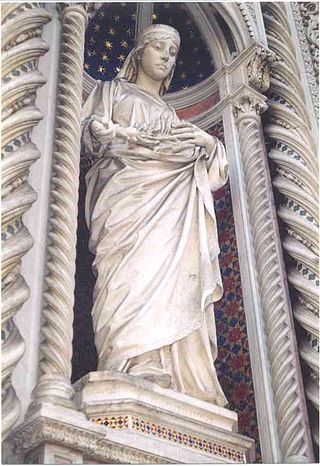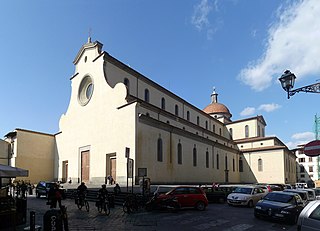Background

Michele di Lando was the son of a woman named Simona who was a vegetable seller in Florence. Michele himself was a wool carder. [2]
Michele di Lando was the first leader of the Ciompi Revolt in Florence that started in 1378. [1]

Michele di Lando was the son of a woman named Simona who was a vegetable seller in Florence. Michele himself was a wool carder. [2]
There was much discontent in Florence in 1378. Salvestro de' Medici was challenging the authority of the Guelf Party and facing heavy resistance from the nobility. Moreover, many workers in Florence remained without a guild to represent them and were therefore entirely disenfranchised. [3] On 22 July 1378, violence broke out in Florence once again. Michele di Lando went to the Piazza of the Signoria where he was given a banner of justice with which to lead the people. He ordered that the Palace of the Signoria should be taken and the governors chose to flee. [4] Michele took power and for six weeks, he fought to restore stability. [5] His government had three new guilds created so that almost all men gained representation. [6]
However the radicals were not happy with the new government for many of the old structures of government remained so they selected the Eight of Santa Maria Novella to represent them instead. This led to a conflict between the Priors led by Michele and the Eight. Michele was able to defeat the radicals and so returned to power. As a result of the revolt, he had the guild representing the lowest workers and the apprentices disbanded but left the others intact. [7]

Florence is the capital city of the region of Tuscany in Central Italy. It is also the most populated city in Tuscany, with 360,930 inhabitants in 2023, and 984,991 in its metropolitan area.

The House of Medici was an Italian banking family and political dynasty that first consolidated power in the Republic of Florence under Cosimo de' Medici, during the first half of the 15th century. The family originated in the Mugello region of Tuscany, and prospered gradually until it was able to fund the Medici Bank. This bank was the largest in Europe during the 15th century and facilitated the Medicis' rise to political power in Florence, although they officially remained citizens rather than monarchs until the 16th century.

Andrea del Verrocchio, born Andrea di Michele di Francesco de' Cioni, was a sculptor, Italian painter and goldsmith who was a master of an important workshop in Florence.

Giovanni di Bicci de' Medici was an Italian banker and founder of the Medici Bank. While other members of the Medici family, such as Chiarissimo di Giambuono de' Medici, who served in the Signoria of Florence in 1401, and Salvestro de' Medici, who was implicated in the Ciompi Revolt of 1378, are of historical interest, it was Giovanni's founding of the family bank that truly initiated the family's rise to power in Florence. He was the father of Cosimo de' Medici and of Lorenzo the Elder; grandfather of Piero di Cosimo de' Medici; great-grandfather of Lorenzo de' Medici ; and the great-great-great-grandfather of Cosimo I de' Medici, Grand Duke of Tuscany.

The Republic of Florence, known officially as the Florentine Republic, was a medieval and early modern state that was centered on the Italian city of Florence in Tuscany, Italy. The republic originated in 1115, when the Florentine people rebelled against the Margraviate of Tuscany upon the death of Matilda of Tuscany, who controlled vast territories that included Florence. The Florentines formed a commune in her successors' place. The republic was ruled by a council known as the Signoria of Florence. The signoria was chosen by the gonfaloniere, who was elected every two months by Florentine guild members.

Carrara is a city and comune in Tuscany, in central Italy, of the province of Massa and Carrara, and notable for the white or blue-grey marble quarried there. It is on the Carrione River, some 100 kilometres (62 mi) west-northwest of Florence. Its motto is Fortitudo mea in rota.

Giovanni Villani was an Italian banker, official, diplomat and chronicler from Florence who wrote the Nuova Cronica on the history of Florence. He was a leading statesman of Florence but later gained an unsavoury reputation and served time in prison as a result of the bankruptcy of a trading and banking company he worked for. His interest in and elaboration of economic details, statistical information, and political and psychological insight mark him as a more modern chronicler of late medieval Europe. His Cronica is viewed as the first introduction of statistics as a positive element in history. However, historian Kenneth R. Bartlett notes that, in contrast to his Renaissance-era successors, "his reliance on such elements as divine providence links Villani closely with the medieval vernacular chronicle tradition." In recurring themes made implicit through significant events described in his Cronica, Villani also emphasized three assumptions about the relationship of sin and morality to historical events, these being that excess brings disaster, that forces of right and wrong are in constant struggle, and that events are directly influenced by the will of God.

The Palazzo Vecchio is the town hall of Florence, Italy. It overlooks the Piazza della Signoria, which holds a copy of Michelangelo's David statue, and the gallery of statues in the adjacent Loggia dei Lanzi.
The Ciompi Revolt was a rebellion among unrepresented labourers which occurred in the Republic of Florence, from 1378 to 1382. Those who revolted consisted of artisans, labourers, and craftsmen who did not belong to any guilds and were therefore unable to participate in the Florentine government. These labourers had grown increasingly resentful over the established patrician oligarchy. In addition, they were expected to pay heavy taxes which they could not afford, forcing some to abandon their homes. The resulting insurrection over such tensions led to the creation of a government composed of wool workers and other disenfranchised workers which lasted for three and a half years.

Popular revolts in late medieval Europe were uprisings and rebellions by peasants in the countryside, or the burgess in towns, against nobles, abbots and kings during the upheavals between 1300 and 1500, part of a larger "Crisis of the Late Middle Ages". Although sometimes known as Peasant Revolts, the phenomenon of popular uprisings was of broad scope and not just restricted to peasants. In Central Europe and the Balkan region, these rebellions expressed, and helped cause, a political and social disunity paving the way for the expansion of the Ottoman Empire.
The War of the Eight Saints (1375–1378) was a war between Pope Gregory XI and a coalition of Italian city-states led by Florence that contributed to the end of the Avignon Papacy.

The Albizzi family was a Florentine family originally based in Arezzo, who were rivals of the Medici and Alberti families. They were at the centre of Florentine oligarchy from 1382, in the reaction that followed the Ciompi revolt, to the rise of the Medici in 1434. They were active members of the Arte della Lana, Florence's wool guild. The Guilds played a central role in the governance of the Republic of Florence during the medieval period and guild members constituted Florence's political and economic oligarchy.

Salvestro di Alamanno de' Medici was a former Gonfaloniere and Provost of the city of Florence.

Florence weathered the decline of the Western Roman Empire to emerge as a financial hub of Europe, home to several banks including that of the politically powerful Medici family. The city's wealth supported the development of art during the Italian Renaissance, and tourism attracted by its rich history continues today.
The music of Florence is foundational in the history of Western European music. Music was an important part of the Italian Renaissance. It was in Florence that the Florentine Camerata convened in the mid-16th century and experimented with setting tales of Greek mythology to music and staging the result—in other words, the first operas, setting the wheels in motion not just for the further development of the operatic form, but for later developments of separate "classical" forms such as the symphony.

The Arte della Lana was the wool guild of Florence during the Late Middle Ages and in the Renaissance. It was one of the seven Arti Maggiori ("greater trades") of Florence, separate from the Arti Minori and the Arti Mediane (the "middle trades"). The Arte della Lana dealt in woollen cloth and cooperated with the other corporations of bankers and merchants in administering the commune, both under the podestà and the Republic of Florence. The powerful Albizzi family were prominent members of the guild.

The Basilica di Santo Spirito is a church in Florence, Italy. Usually referred to simply as Santo Spirito, it is located in the Oltrarno quarter, facing the square with the same name. The interior of the building – internal length 97 m (318 ft) – is one of the preeminent examples of Renaissance architecture.

The guilds of Florence were secular corporations that controlled the arts and trades in Florence from the twelfth into the sixteenth century. These Arti included seven major guilds, five middle guilds and nine minor guilds. Their rigorous quality control and the political role in the commune that the Arti Maggiori assumed were formative influences in the history of Florence, which became one of the richest cities of late Medieval Europe.

Gregorio (Goro) Dati was a Florentine merchant and diarist best known for the authorship of The Diaries of Gregorio Dati, which represents a major source for social and economic historians of Renaissance Florence, alongside the diaries of Buonaccorso Pitti. He kept a detailed diary outlining his business dealings as well as personal information about the births and deaths of his four successive wives and his 26 children.
The Eight of Santa Maria Novella were a radical group involved in the Ciompi Revolt in Florence in 1378.